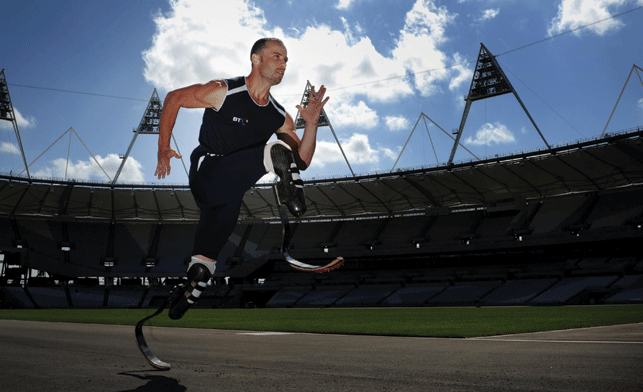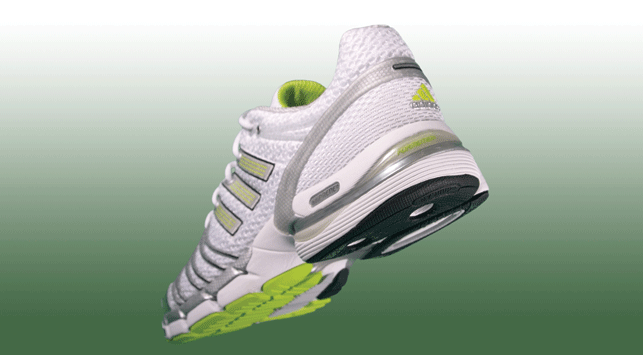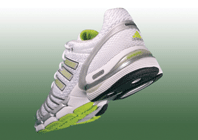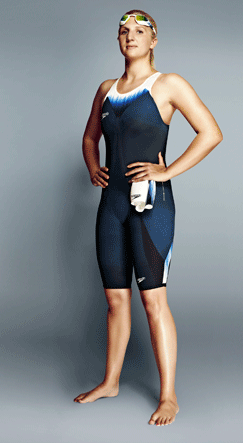Running on edge
Known as the ‘Blade Runner’, South African double amputee Oscar Pistorius is the world record holder in the 100, 200 and 400 metres events. He runs with the aid of Cheetah Flex-Foot carbon fibre transtibial artificial limbs by Icelandic prosthesis expert Össur.

Oscar Pistorius runs with the aid of Cheetah Flex-Foot carbon fibre transtibial artificial limbs in the London Olympic stadium
Flex-Foot Cheetahs have been used by Paralympic athletes since 1996 and have been scientifically proven to not give a net advantage over able-bodied athletes. Pistorius has been competing with the same custom designed Össur blades since 2004 and achieved a personal best time of 45.07s in Lignano, Italy in July 2011.
Flex-Foot Cheetahs are lighter (approximately 2.8kg) than a human foot and calf. They facilitate an unnaturally shorter swing time, which enables more strides to be taken.
When running, the prosthesis’ ‘J curve’ is compressed at impact, storing energy and absorbing high levels of stress that would otherwise be absorbed by the runner’s ankle, knee, hip, and lower back.
At the end of stance phase, the ‘J curve’ returns back to its original shape, releasing the stored energy and propelling the user forward.
Using aerospace technology, the Cheetah is designed to have more layers of carbon at higher stress points, such as the apex of the “J” curve, and less carbon where more flexibility is needed, such as the toe portion.
Importantly, the Flex-Foot Cheetah has no heel component. This ensures that the prosthetic foot’s reaction accurately mimics that of an able-bodied runner replicating both the stance and swing phases of running.
The design process for professional athletes is incredibly bespoke, creating a one-off product that is tuned as highly as any other important piece of sports equipment.
After initial concept sketches the team of engineers work in SolidWorks to build a 3D model that can be used in SolidWorks Simulation for developing simulation models for testing, FEA and composite structure.
If, as expected, Pistorius qualifies for the South African national team at the end of June, we’ll be looking forward to seeing him cross the finishing line of the Men’s 400m in London this summer.
www.ossur.com
www.oscarpistorius.com
Slick-skinned speed
Even if your skin is as smooth as a baby’s bottom, there’s always a way to slip through the water faster with a cutting edge swimsuit from Speedo.
With Olympic swimmers this summer looking to shave fractions of seconds from their race times, many are turning to Speedo’s revolutionary Fastskin Racing System to streamline their performance thanks to its drag-reducing design.
When worn together as a complete system, a FastSkin suit, cap and goggles can reduce full-body passive drag by up to 16.6 per cent, improve oxygen economy by up to 11 per cent and reduce active body drag by up to 5.2 per cent.
“Engineering simulation has been absolutely critical in launching this world-first concept,” said Tom Waller, head of Speedo’s in-house global research and development facility, Aqualab.
The engineering team worked with Ansys’ CFD software, undertaking more than 1,200 separate simulations replicating the dynamic pressures of competitive swimming in a risk-free virtual design environment.
The simulations helped minimise the effects of turbulence and drag, mitigate the impact force generated by a dive, maximise the structural strength of the goggle assembly, and address other real-world design concerns.
For the goggles, for example, Ansys solutions offered insight about the structural forces that impact the equipment from all directions, which lightweight material would be able to withstand those forces, and how the shape generated turbulence that could negatively impact the swimmer’s performance.
Following the design work, Speedo conducted a number of pool tests of the new racing system, using professional athletes including 16-time Olympic medal winner Michael Phelps of the USA, and Britain’s Rebecca Adlington who we’ll be cheering for.
www.speedo.com
Sole power

Adidas ForMotion running shoes with motion-responsive, stress-reducing heels
Running shoe designers at Adidas know that a twisted knee, or one bad turn of the ankle can prove disastrous for an athlete when training or in the midst of a competition.
Working with a team of material engineers and biomechanists it sets out to make footwear that adapts to an individual athlete’s movements.
From its top-secret facilities in Germany and the USA, the manufacturer incorporates motion-responsive, stress-reducing technologies into the heels of its running shoes.
In the Adidas ForMotion running shoes, sliding polyamide plates form spherical bearings in the heel of the shoe. These absorb the shock of a runner’s foot hitting the ground in three directions – vertical, horizontal and rotational.
This slows down ‘sole angle velocity’ and prevents shin splints. The plates also rotate to counteract pronation, the amount your foot rolls inwards with each step, which is the biggest cause of knee injury.
Heel units also adjust to foot strike, or how turned out the feet are when running.
Combining materials science, biomechanics from video of actual runners, and digital models in Dassault Systèmes software, Adidas engineers create virtual shoe prototypes.
The engineers use Abaqus within Simulia to run FEA evaluations, observing how the ForMotion unit functions under different simulated running conditions.
The designers also take anatomical cross section views and use 3DS simulations to calculate heel stiffness required for particular shoe sizes.
www.adidas.com
The tools of champions designed by legends
Default







